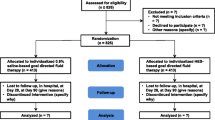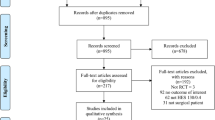Abstract
Purpose
To compare the effects of predominantly hydroxyethyl starch (HES 6% 130/0.4)-based with predominantly gelatin 4%-based fluid therapy on renal function in surgical intensive care unit (ICU) patients.
Methods
Before–after, retrospective, study of surgical ICU patients. All patients admitted from January to June 2005 formed the HES group, with HES 130/0.4 as the standard colloid of choice. All patients admitted from January to June 2006 formed the GEL group, with gelatin 4% as the primary colloid. Acute renal failure (ARF) was defined as new need for renal replacement therapy (RRT) or at least a two-fold increase in baseline creatinine.
Results
There were 1383 patients in the HES group and 1528 in the GEL group; 118 and 87, in each group respectively, had severe sepsis. The incidence of ARF and ICU and hospital mortality rates were similar in the two groups. In a post-hoc multivariable analysis, cumulative doses >33 ml/kg of either HES (OR = 1.85, 95% CI: 1.01–3.41, p < 0.001) or gelatin (OR = 1.99, 95% CI: 1.05–3.79, p = 0.035) were associated with a higher risk of ARF.
Conclusions
The incidence of ARF was similar in patients who received predominantly HES (6% 130/.04) fluid therapy and in those who received predominantly gelatin 4%. Moderate cumulative doses of modern HES or gelatin solutions may be associated with a higher risk of ARF.


Similar content being viewed by others
References
Sakr Y, Payen D, Reinhart K, Sipmann FS, Zavala E, Bewley J, Marx G, Vincent JL (2007) Effects of hydroxyethyl starch administration on renal function in critically ill patients. Br J Anaesth 98:216–224
Finfer S, Bellomo R, Boyce N, French J, Myburgh J, Norton R (2004) A comparison of albumin and saline for fluid resuscitation in the intensive care unit. N Engl J Med 350:2247–2256
Brunkhorst FM (2008) Intensive insulin therapy and pentastarch resuscitation in severe sepsis. N Engl J Med 358:125–139
Treib J, Baron JF, Grauer MT, Strauss RG (1999) An international view of hydroxyethyl starches. Intensive Care Med 25:258–268
Hoffmann JN, Vollmar B, Laschke MW, Inthorn D, Schildberg FW, Menger MD (2002) Hydroxyethyl starch (130 kD), but not crystalloid volume support, improves microcirculation during normotensive endotoxemia. Anesthesiology 97:460–470
Morisaki H, Bloos F, Keys J, Martin C, Neal A, Sibbald WJ (1994) Compared with crystalloid, colloid therapy slows progression of extrapulmonary tissue injury in septic sheep. J Appl Physiol 77:1507–1518
Mishler JM (1984) Synthetic plasma volume expanders—their pharmacology, safety and clinical efficacy. Clin Haematol 13:75–92
Barron ME, Wilkes MM, Navickis RJ (2004) A systematic review of the comparative safety of colloids. Arch Surg 139:552–563
Haskell LP, Tannenberg AM (1988) Elevated urinary specific gravity in acute oliguric renal failure due to hetastarch administration. N Y State J Med 88:387–388
Waldhausen P, Kiesewetter H, Leipnitz G, Scielny J, Jung F, Bambauer R, von Blohn G (1991) Hydroxyethyl starch-induced transient renal failure in preexisting glomerular damage. Acta Med Austriaca 18(Suppl 1):52–55
Dickenmann MJ, Filipovic M, Schneider MC, Brunner FP (1998) Hydroxyethylstarch-associated transient acute renal failure after epidural anaesthesia for labour analgesia and caesarean section. Nephrol Dial Transplant 13:2706
De Labarthe A, Jacobs F, Blot F, Glotz D (2001) Acute renal failure secondary to hydroxyethylstarch administration in a surgical patient. Am J Med 111:417–418
Winkelmayer WC, Glynn RJ, Levin R, Avorn J (2003) Hydroxyethyl starch and change in renal function in patients undergoing coronary artery bypass graft surgery. Kidney Int 64:1046–1049
Legendre C, Thervet E, Page B, Percheron A, Noel LH, Kreis H (1993) Hydroxyethylstarch and osmotic-nephrosis-like lesions in kidney transplantation. Lancet 342:248–249
Cittanova ML, Leblanc I, Legendre C, Mouquet C, Riou B, Coriat P (1996) Effect of hydroxyethylstarch in brain-dead kidney donors on renal function in kidney-transplant recipients. Lancet 348:1620–1622
Deman A, Peeters P, Sennesael J (1999) Hydroxyethyl starch does not impair immediate renal function in kidney transplant recipients: a retrospective, multicentre analysis. Nephrol Dial Transplant 14:1517–1520
Kumle B, Boldt J, Piper S, Schmidt C, Suttner S, Salopek S (1999) The influence of different intravascular volume replacement regimens on renal function in the elderly. Anesth Analg 89:1124–1130
Boldt J, Brenner T, Lehmann A, Lang J, Kumle B, Werling C (2003) Influence of two different volume replacement regimens on renal function in elderly patients undergoing cardiac surgery: comparison of a new starch preparation with gelatin. Intensive Care Med 29:763–769
Schortgen F, Brochard L, Burnham E, Martin GS (2003) Pro/con clinical debate: hydroxyethylstarches should be avoided in septic patients. Crit Care 7:279–281
Schildt B, Bouveng R, Sollenberg M (1975) Plasma substitute induced impairment of the reticuloendothelial system function. Acta Chir Scand 141:7–13
Walley KR, McDonald TE, Wang Y, Dai S, Russell JA (2003) Albumin resuscitation increases cardiomyocyte contractility and decreases nitric oxide synthase II expression in rat endotoxemia. Crit Care Med 31:187–194
Schortgen F, Lacherade JC, Bruneel F, Cattaneo I, Hemery F, Lemaire F, Brochard L (2001) Effects of hydroxyethylstarch and gelatin on renal function in severe sepsis: a multicentre randomised study. Lancet 357:911–916
Suttner S, Boldt J (2004) Volume replacement with hydroxyethyl starch: is there an influence on kidney function? Anasthesiol Intensivmed Notfallmed Schmerzther 39:71–77
Muller L, Jaber S, Lefrant JY (2008) Insulin and pentastarch for severe sepsis. N Engl J Med 358:2072–2073
Jungheinrich C, Scharpf R, Wargenau M, Bepperling F, Baron JF (2002) The pharmacokinetics and tolerability of an intravenous infusion of the new hydroxyethyl starch 130/0.4 (6%, 500 mL) in mild-to-severe renal impairment. Anesth Analg 95:544–551
FDA Center for Biologics Evaluation and ResearchNDA Review memo (mid-cycle) Available at: http://www.fda.gov/Cber/nda/voluven/voluvenmidmem.pdf. Accessed on September 3 2008
Le Gall JR, Lemeshow S, Saulnier F (1993) A new simplified acute physiology score (SAPS II) based on a European/North American multicenter study. JAMA 270:2957–2963
Vincent JL, de Mendonca A, Cantraine F, Moreno R, Takala J, Suter PM, Sprung CL, Colardyn F, Blecher S (1998) Use of the SOFA score to assess the incidence of organ dysfunction/failure in intensive care units: results of a multicenter, prospective study. Working group on “sepsis-related problems” of the European Society of Intensive Care Medicine. Crit Care Med 26:1793–1800
American College of Chest Physicians/Society of Critical Care Medicine (1992) Consensus conference: definitions for sepsis and organ failure and guidelines for the use of innovative therapies in sepsis. Crit Care Med 20:864–874
Dellinger RP, Carlet JM, Masur H, Gerlach H, Calandra T, Cohen J, Gea-Banacloche J, Keh D, Marshall JC, Parker MM, Ramsay G, Zimmerman JL, Vincent JL, Levy MM (2004) Surviving sepsis campaign guidelines for management of severe sepsis and septic shock. Intensive Care Med 30:536–555
Reinhart K, Brunkhorst F, Bone H, Gerlach H, Grundling M, Kreymann G, Kujath P, Marggraf G, Mayer K, Meier-Hellmann A, Peckelsen C, Putensen C, Quintel M, Ragaller M, Rossaint R, Stuber F, Weiler N, Welte T, Werdan K (2006) Diagnosis and therapy of sepsis: guidelines of the German Sepsis Society Inc. and the German Interdisciplinary Society for Intensive and Emergency Medicine. Anaesthesist 55(Suppl 1):43–56
Hussain SF, Drew PJ (1989) Acute renal failure after infusion of gelatins. BMJ 299:1137–1138
Stockwell MA, Scott A, Day A, Riley B, Soni N (1992) Colloid solutions in the critically ill. A randomised comparison of albumin and polygeline 2. Serum albumin concentration and incidences of pulmonary oedema and acute renal failure. Anaesthesia 47:7–9
Trull A, Hughes V, Cooper D, Wilkins M, Gimson A, Friend P, Johnston A, Sharples L, Park G (2002) Influence of albumin supplementation on tacrolimus and cyclosporine therapy early after liver transplantation. Liver Transpl 8:224–232
Boldt J, Brosch C, Rohm K, Papsdorf M, Mengistu A (2008) Comparison of the effects of gelatin and a modern hydroxyethyl starch solution on renal function and inflammatory response in elderly cardiac surgery patients. Br J Anaesth 100:457–464
Mahmood A, Gosling P, Vohra RK (2007) Randomized clinical trial comparing the effects on renal function of hydroxyethyl starch or gelatine during aortic aneurysm surgery. Br J Surg 94:427–433
Boldt J, Brosch C, Ducke M, Papsdorf M, Lehmann A (2007) Influence of volume therapy with a modern hydroxyethylstarch preparation on kidney function in cardiac surgery patients with compromised renal function: a comparison with human albumin. Crit Care Med 35:2740–2746
Wiesen P, Canivet JL, Ledoux D, Roediger L, Damas P (2005) Effect of hydroxyethylstarch on renal function in cardiac surgery: a large scale retrospective study. Acta Anaesthesiol Belg 56:257–263
Liet JM, Bellouin AS, Boscher C, Lejus C, Roze JC (2003) Plasma volume expansion by medium molecular weight hydroxyethyl starch in neonates: a pilot study. Pediatr Crit Care Med 4:305–307
Beyer R, Harmening U, Rittmeyer O, Zielmann S, Mielck F, Kazmaier S, Kettler D (1997) Use of modified fluid gelatin and hydroxyethyl starch for colloidal volume replacement in major orthopaedic surgery. Br J Anaesth 78:44–50
Vogt N, Bothner U, Brinkmann A, de Petriconi R, Georgieff M (1999) Peri-operative tolerance to large-dose 6% HES 200/0.5 in major urological procedures compared with 5% human albumin. Anaesthesia 54:121–127
Arellano R, Gan BS, Salpeter MJ, Yeo E, McCluskey S, Pinto R, Irish J, Ross DC, Doyle DJ, Parkin J, Brown D, Rotstein L, Witterick I, Matthews W, Yoo J, Neligan PC, Gullane P, Lampe H (2005) A triple-blinded randomized trial comparing the hemostatic effects of large-dose 10% hydroxyethyl starch 264/0.45 versus 5% albumin during major reconstructive surgery. Anesth Analg 100:1846–1853
Schortgen F, Girou E, Deye N, Brochard L (2008) The risk associated with hyperoncotic colloids in patients with shock. Intensive Care Med 34:2157–2168
Wiedermann CJ (2008) Systematic review of randomized clinical trials on the use of hydroxyethyl starch for fluid management in sepsis. BMC Emerg Med 8:1
Haynes GR, Havidich JE, Payne KJ (2004) Why the food and drug administration changed the warning label for hetastarch. Anesthesiology 101:560–561
Wilkes MM, Navickis RJ, Sibbald WJ (2001) Albumin versus hydroxyethyl starch in cardiopulmonary bypass surgery: a meta-analysis of postoperative bleeding. Ann Thorac Surg 72:527–533
Financial support
No funding was obtained in support of this analysis.
Conflict of interest statement
KR has received speaker’s and consultancy fees from B. Braun GmbH, Melsungen, Germany. FS, JO, FT, AL, YS, CH and DB report no conflict of interest.
Author information
Authors and Affiliations
Corresponding author
Electronic supplementary material
Below is the link to the electronic supplementary material.
Rights and permissions
About this article
Cite this article
Schabinski, F., Oishi, J., Tuche, F. et al. Effects of a predominantly hydroxyethyl starch (HES)-based and a predominantly non HES-based fluid therapy on renal function in surgical ICU patients. Intensive Care Med 35, 1539–1547 (2009). https://doi.org/10.1007/s00134-009-1509-1
Received:
Accepted:
Published:
Issue Date:
DOI: https://doi.org/10.1007/s00134-009-1509-1




